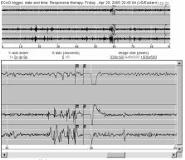COMPLEMENTING THE RESPONSIVE NEUROSTIMULATOR SYSTEM WITH A PATIENT OPERATED DATA TRANSMITTER [ndash] ON DEMAND MONITORING IN THE OUTPATIENT ENVIRONMENT
Abstract number :
2.391
Submission category :
Year :
2005
Submission ID :
5698
Source :
www.aesnet.org
Presentation date :
12/3/2005 12:00:00 AM
Published date :
Dec 2, 2005, 06:00 AM
Authors :
1Eva Katharina Ritzl, 1Eric H. Kossoff, 1Gregory K. Bergey, 1Pam S. Coe, and 2Deepak S. Gupta
The Responsive Neurostimulator System (RNS TM) is an investigational device currently undergoing study for the treatment of intractable epilepsy. The RNS continuously monitors cortical activity and delivers stimulation in response to detected epileptiform activity. The RNS is capable of storing detailed diagnostics and electrocorticograms (ECOGs), but has limited internal memory capabilities. As a result, patients being seen on a typical follow-up schedule will have much of the collected diagnostic data overwritten prior to their infrequent office visits. To provide better follow-up and a more continuous diagnostic record, a patient operable Data Transmitter (DTR) has been developed. IRB approval was obtained for the investigational use of the RNS and DTR as part of a multicenter trial. Five patients have been implanted with RNS[apos]s at our center. All have been given DTR[apos]s. Interrogation of the RNS is accomplished by simply placing the DTR wand over the RNS. Data transfer occurs via transcutaneous telemetry. On an intermittent basis, the DTR is connected to a phone line and data is transmitted to the secure server where it can be viewed by the treating physician over any Internet connected computer. All patients were able to use the DTR without difficulty. Each patient established a flexible interrogation schedule in keeping with his or her treatment requirements and lifestyle. Immediate interrogation after the occurrence of a break through seizure provided valuable information in individual cases.
The time required to download data from the RNS to the DTR ranged from 20 seconds to 3 minutes for an RNS with a full memory buffer. The phone line transmission time was dependent on the amount of data collected since the last transmission, but was usually less than 10 minutes.
An example of an ECOG downloaded and transmitted by the DTR is shown in figure 1. The upper panel is the entire ECOG (90 seconds) and the lower panel is a scrollable 10-second view. Detailed reports are also available on the secure server and provide summary statistics since the last interrogation. The DTR allows remote assessment of RNS data regarding detections and stimulations, as well as ECOGs captured according to a schedule or in response to a clinical event. Patients were able to use the device with ease. The clinician can then make treatment decisions based on objective, quantitative real-time clinical data.[figure1] (Supported by NeuroPace, Inc.)
